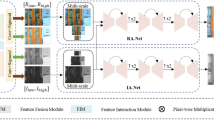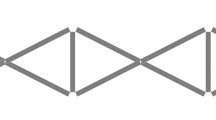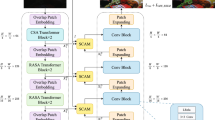Abstract
Due to the limitations of devices, images taken in low-light environments are of low contrast and high noise without any manual intervention. Such images will affect the visual experience and hinder further visual processing tasks, such as target detection and target tracking. To alleviate this issue, we propose a multi-scale joint low-light enhancement network based on the Retinex theory. The network consists of a decomposition part and an enhancement part. As a joint network, the decomposition and enhancement parts are mutually constrained, and the parameters are updated at the same time so that the image processing results are more excellent in detail. Our algorithm avoids the separation and recombination of decomposition and enhancement. Therefore, less information is lost in the processing of low-light images, and the enhancement result of the proposed algorithm is very close to the ground truth. In addition, in the enhancement part, we adopt a multi-scale network to fully extract image features. The multi-scale network maintains a balance between the global and local luminance of the illumination image. Retinex theory can effectively solve the problem of noise amplification and color distortion. At the same time, we have added color loss to solve the problem of color distortion, so that the enhancement result is closer to the normal-light image in color. The enhancement results are intuitively excellent, and the peak signal-to-noise ratio and structural similarity index results also reflect the reliability of the algorithm.






Similar content being viewed by others
References
Maini, R., Aggarwal, H.: A comprehensive review of image enhancement techniques (2010). arXiv preprint arXiv:1003.4053
Pisano, E.D., Zong, S., Hemminger, B.M., DeLuca, M., Johnston, R.E., Muller, K., Braeuning, M.P., Pizer, S.M.: Contrast limited adaptive histogram equalization image processing to improve the detection of simulated spiculations in dense mammograms. J. Digit. Imaging 11(4), 193 (1998)
Dong, X., Wang, G., Pang, Y., Li, W., Wen, J., Meng, W., Lu, Y.: Fast efficient algorithm for enhancement of low lighting video. In: Proceedings of IEEE International Conference on Multimedia and Expo, pp. 1–6 (2011)
Land, E.H., McCann, J.J.: Lightness and Retinex theory. Josa 61(1), 1–11 (1971)
Jobson, D.J., Rahman, Z.U., Woodell, G.A.: Properties and performance of a center/surround retinex. IEEE Trans. Image Process. 6(3), 451–462 (1997)
Jobson, D.J., Rahman, Z.U., Woodell, G.A.: A multiscale retinex for bridging the gap between color images and the human observation of scenes. IEEE Trans. Image Process. 6(7), 965–976 (1997)
Fu, X., Zeng, D., Huang, Y., Zhang, X.P., Ding, X.: A weighted variational model for simultaneous reflectance and illumination estimation. In: Proceedings of the IEEE Conference on Computer Vision and Pattern Recognition, pp. 2782–2790 (2016)
Guo, X., Li, Y., Ling, H.: Lime: low-light image enhancement via illumination map estimation. IEEE Trans. Image Process. 26(2), 982–993 (2016)
Li, X., Song, D., Dong, Y.: Hierarchical feature fusion network for salient object detection. IEEE Trans. Image Process. 29, 9165–9175 (2020)
Liu, L., Cao, J.: End-to-end learning interpolation for object tracking in low frame-rate video. IET Image Process. 14(6), 1066–1072 (2020)
Lore, K.G., Akintayo, A., Sarkar, S.: Llnet: a deep autoencoder approach to natural low-light image enhancement. Pattern Recognit. 61, 650–662 (2017)
Ignatov, A., Kobyshev, N., Timofte, R., Vanhoey, K., Van Gool, L.: Wespe: weakly supervised photo enhancer for digital cameras. In: Proceedings of the IEEE Conference on Computer Vision and Pattern Recognition Workshops, pp. 691–700 (2018)
Ren, W., Liu, S., Ma, L., Xu, Q., Xu, X., Cao, X., Du, J., Yang, M.H.: Low-light image enhancement via a deep hybrid network. IEEE Trans. Image Process. 28(9), 4364–4375 (2019)
Ibrahim, H., Kong, N.S.P.: Brightness preserving dynamic histogram equalization for image contrast enhancement. IEEE Trans. Consum. Electron. 53(4), 1752–1758 (2007)
Wang, C., Ye, Z.: Brightness preserving histogram equalization with maximum entropy: a variational perspective. IEEE Trans. Consum. Electron. 51(4), 1326–1334 (2005)
Chen, S.D., Ramli, A.R.: Minimum mean brightness error bi-histogram equalization in contrast enhancement. IEEE Trans. Consum. Electron. 49(4), 1310–1319 (2003)
Reza, A.M.: Realization of the contrast limited adaptive histogram equalization (clahe) for real-time image enhancement. J. VLSI Signal Process. Syst. Signal Image Video Technol. 38(1), 35–44 (2004)
Stark, J.A.: Adaptive image contrast enhancement using generalizations of histogram equalization. IEEE Trans. Image Process. 9(5), 889–896 (2000)
Li, L., Wang, R., Wang, W., Gao, W.: A low-light image enhancement method for both denoising and contrast enlarging. In: Proceedings of International Conference on Image Processing, pp. 3730–3734 (2015)
Shen, L., Yue, Z., Feng, F., Chen, Q., Liu, S., Ma, J.: Msr-net: low-light image enhancement using deep convolutional network (2017). arXiv preprint arXiv:1711.02488
Lee, C.H., Shih, J.L., Lien, C.C., Han, C.C.: Adaptive multiscale retinex for image contrast enhancement. In: Proceedings of International Conference on Signal-Image Technology and Internet-Based Systems, pp. 43–50 (2013)
Wang, R., Zhang, Q., Fu, C.W., Shen, X., Zheng, W.S., Jia, J.: Underexposed photo enhancement using deep illumination estimation. In: Proceedings of the IEEE Conference on Computer Vision and Pattern Recognition, pp. 6849–6857 (2019)
Chen, C., Chen, Q., Xu, J., Koltun, V.: Learning to see in the dark. In: Proceedings of the IEEE Conference on Computer Vision and Pattern Recognition, pp. 3291–3300 (2018)
Yang, W., Zhang, X., Tian, Y., Wang, W., Xue, J.H., Liao, Q.: Deep learning for single image super-resolution: a brief review. IEEE Trans. Multimed. 21(12), 3106–3121 (2019)
Cai, J., Gu, S., Zhang, L.: Learning a deep single image contrast enhancer from multi-exposure images. IEEE Trans. Image Process. 27(4), 2049–2062 (2018)
Zhang, Y., Zhang, J., Guo, X.: Kindling the darkness: a practical low-light image enhancer. In: Proceedings of the ACM International Conference on Multimedia, pp. 1632–1640 (2019)
Wei, C., Wang, W., Yang, W., Liu, J.: Deep retinex decomposition for low-light enhancement (2018). arXiv preprint arXiv:1808.04560
Gharbi, M., Chen, J., Barron, J.T., Hasinoff, S.W., Durand, F.: Deep bilateral learning for real-time image enhancement. ACM Trans. Graph. 36(4), 1–12 (2017)
Ignatov, A., Kobyshev, N., Timofte, R., Vanhoey, K., Van Gool, L.: Dslr-quality photos on mobile devices with deep convolutional networks. In: Proceedings of the IEEE International Conference on Computer Vision, pp. 3277–3285 (2017)
Li, M., Liu, J., Yang, W., Sun, X., Guo, Z.: Structure-revealing low-light image enhancement via robust retinex model. IEEE Trans. Image Process. 27(6), 2828–2841 (2018)
Xiaochu, W., Guijin, T., Xiaohua, L., Ziguan, C., Suhuai, L.: Low-light color image enhancement based on nsst. J. China Univ. Posts Telecommun. 5, 6 (2019)
Ying, Z., Li, G., Ren, Y., Wang, R., Wang, W.: A new low-light image enhancement algorithm using camera response model. In: Proceedings of the IEEE International Conference on Computer Vision Workshops, pp. 3015–3022 (2017)
Ying, Z., Li, G., Ren, Y., Wang, R., Wang, W.: A new image contrast enhancement algorithm using exposure fusion framework. In: Proceedings of International Conference on Computer Analysis of Images and Patterns, pp. 36–46 (2017)
Author information
Authors and Affiliations
Corresponding author
Additional information
Publisher's Note
Springer Nature remains neutral with regard to jurisdictional claims in published maps and institutional affiliations.
Rights and permissions
About this article
Cite this article
Song, X., Huang, J., Cao, J. et al. Multi-scale joint network based on Retinex theory for low-light enhancement. SIViP 15, 1257–1264 (2021). https://doi.org/10.1007/s11760-021-01856-y
Received:
Revised:
Accepted:
Published:
Issue Date:
DOI: https://doi.org/10.1007/s11760-021-01856-y




